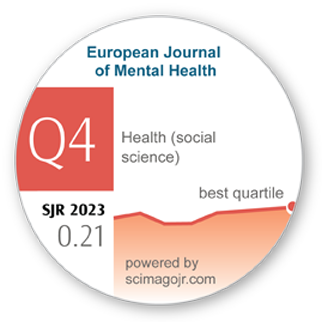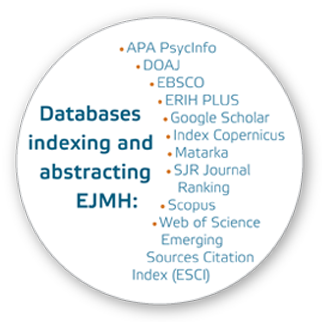The Impact of Cannabis Abstinence on Emotion Recognition and Differentiation
Keywords:
emotion recognition, emotion differentiation, abstinence, cannabis, withdrawalAbstract
Introduction: Cannabis is the second most widely-used substance in India, after alcohol. Several researches show how cannabis use can impair emotion recognition capacity, but relatively few researchers have explored this among cannabis abstainers. Aims: The present study’s authors aimed at assessing emotion recognition, emotion differentiation, self-reported anxiety, depression, stress, withdrawal intensity and impact in a sample of men who abstain from cannabis. Methods: Heavy cannabis users (N = 70 males) were assessed via questionnaires regarding their cannabis use frequency, their age at onset of usage, anxiety, depression, and stress levels as well as their performance on computerised tasks of emotion recognition and discrimination within 24 hours of their admission (T0), then after 15 days of abstinence (T1), and finally after 30 days of abstinence (T2). At T1 and T2, they were also assessed for withdrawal intensity and the impact of withdrawal on daily activities. Results: Findings revealed that, with abstinence, successive improvement in emotion recognition and emotion differentiation developed, even after accounting for declines in psychological distress from T0 to T1. However, from T1 to T2, further declines in psychological distress and withdrawal impact mainly accounted for this improvement. Happiness was the best recognised and well-differentiated emotion while the poorest discrimination was observed for anger. Conclusions: This study’s findings corroborate and significantly add to the limited existing literature, demonstrating improved emotion recognition and differentiation due to initial cannabis abstinence, but later this improvement proceeds with a decline in distress and withdrawal impact.
References
Allsop, D. J., Norberg, M. M., Copeland, J., Fu, S., & Budney,
A. J. (2011). The Cannabis Withdrawal Scale development:
Patterns and predictors of cannabis withdrawal and distress.
Drug and Alcohol Dependence, 119(1–2), 123–129.
https://doi.org/10.1016/j.drugalcdep.2011.06.003
Aguirre Velasco, A., Cruz, I. S. S., Billings, J., Jimenez, M., & Rowe, S. (2020). What are the barriers, facilitators and interventions targeting help-seeking behaviours for common mental health problems in adolescents? A systematic review. BMC psychiatry, 20, Article 293.
https://doi.org/10.1186/s12888-020-02659-0
Allsop, D. J., Norberg, M. M., Copeland, J., Fu, S., & Budney, A. J. (2011). The Cannabis Withdrawal Scale development: Patterns and predictors of cannabis withdrawal and distress. Drug and Alcohol Dependence, 119(1–2), 123–129.
https://doi.org/10.1016/j.drugalcdep.2011.06.003
Allsop, D. J., Norberg, M. M., Copeland, J., Fu, S., & Budney, A. J. (2011). The Cannabis Withdrawal Scale development: Patterns and predictors of cannabis withdrawal and distress. Drug and Alcohol Dependence, 119(1–2), 123–129.
https://doi.org/10.1016/j.drugalcdep.2011.06.003
Ambekar, A., Agrawal, A., Rao, R., Mishra, A. K., Khandelwal, S. K., & Chadda, R. K. (2019). Magnitude of Substance Use in India. New Delhi: Ministry of Social Justice and Empowerment, Government of India.
Ballard, M. E., Bedi, G., & de Wit, H. (2012). Effects of delta-9-tetrahydrocannabinol on evaluation of emotional images. Journal of Psychopharmacology, 26(10), 1289–1298.
https://doi.org/10.1177/0269881112446530
Bayrakçı, A., Sert, E., Zorlu, N., Erol, A., Sarıçiçek, A., & Mete, L. (2015). Facial emotion recognition deficits in abstinent cannabis dependent patients. Comprehensive Psychiatry, 58, 160–164.
https://doi.org/10.1016/j.comppsych.2014.11.008
Bhatnagar, P., Singh, M., Pandey, M., & Sandhya, A. (2011). Manual for Anxiety, Depression and Stress Scale. National Psychological Corporation. Can you add a link to this reference? We can't find it online.
Bonnet, U., Specka, M., & Scherbaum, N. (2016). Häufiger Konsum von nicht-medizinischem Cannabis: Gesundheitliche Folgen und Wirkung der Entzugbehandlung [Frequent non-medical cannabis use: health sequelae and effectiveness of detoxification treatment]. Deutsche Medizinische Wochenschrift, 141(2), 126–131.
https://doi.org/10.1055/s-0041-106313
Bonnet, U., Specka, M., Stratmann, U., Ochwadt, R., & Scherbaum, N. (2014). Abstinence phenomena of chronic cannabis-addicts prospectively monitored during controlled inpatient detoxification: Cannabis withdrawal syndrome and its correlation with delta-9-tetrahydrocannabinol and-metabolites in serum. Drug and Alcohol Dependence, 143, 189–197.
https://doi.org/10.1016/j.drugalcdep.2014.07.027
Bora, E., & Zorlu, N. (2017). Social cognition in alcohol use disorder: A meta‐analysis. Addiction, 112(1), 40-48.
https://doi.org/10.1111/add.13486
Bossong, M. G., van Hell, H. H., Jager, G., Kahn, R. S., Ramsey, N. F., & Jansma, J. M. (2013). The endocannabinoid system and emotional processing: A pharmacological fMRI study with ∆9-tetrahydrocannabinol. European Neuropsychopharmacology, 23(12), 1687–1697.
https://doi.org/10.1016/j.euroneuro.2013.06.009
Botsford, S. L., Yang, S., & George, T. P. (2020). Cannabis and cannabinoids in mood and anxiety disorders: Impact on illness onset and course, and assessment of therapeutic potential. The American Journal on Addictions, 29(1), 9–26.
https://doi.org/10.1111/ajad.12963
Bourke, C., Douglas, K., & Porter, R. (2010). Processing of facial emotion expression in major depression: A review. Australian & New Zealand Journal of Psychiatry, 44(8), 681–696.
https://doi.org/10.3109/00048674.2010.496359
Budney, A. J., & Hughes, J. R. (2006). The cannabis withdrawal syndrome. Current Opinion in Psychiatry, 19(3), 233–238.
https://doi.org/10.1097/01.yco.0000218592.00689.e5
Budney, A. J., Moore, B. A., Vandrey, R. G., & Hughes, J. R. (2003). The time course and significance of cannabis withdrawal. Journal of Abnormal Psychology, 112(3), 393–402.
https://doi.org/10.1037/0021-843X.112.3.393
Budney, A. J., Vandrey, R. G., Hughes, J. R., Thostenson, J. D., & Bursac, Z. (2008). Comparison of cannabis and tobacco withdrawal: Severity and contribution to relapse. Journal of Substance Abuse Treatment, 35(4), 362–368.
https://doi.org/10.1016/j.jsat.2008.01.002
Castellano, F., Bartoli, F., Crocamo, C., Gamba, G., Tremolada, M., Santambrogio, J., Clerici, M., & Carrà, G. (2015). Facial emotion recognition in alcohol and substance use disorders: A meta-analysis. Neuroscience & Biobehavioral Reviews, 59, 147–154.
https://doi.org/10.1016/j.neubiorev.2015.11.001
Cohn, J. F., & Schmidt, K. L. (2004). The timing of facial motion in posed and spontaneous smiles. International Journal of Wavelets, Multiresolution and Information Processing, 2(2), 121–132.
https://doi.org/10.1142/S021969130400041X
Connor, J. P., Stjepanović, D., Le Foll, B., Hoch, E., Budney, A. J., & Hall, W. D. (2021). Cannabis use and cannabis use disorder. Nature Reviews Disease Primers, 7, 16.
https://doi.org/10.1038/s41572-021-00247-4
Cooke, M. E., Gilman, J. M., Lamberth, E., Rychik, N., Tervo-Clemmens, B., Evins, A. E., & Schuster, R. M. (2021). Assessing changes in symptoms of depression and anxiety during four weeks of cannabis abstinence among adolescents. Frontiers in Psychiatry, 12, Article 689957.
https://doi.org/10.3389/fpsyt.2021.689957
Cousijn, J., & van Duijvenvoorde, A. C. K. (2018). Cognitive and mental health predictors of withdrawal severity during an active attempt to cut down cannabis use. Frontiers in Psychiatry, 9, Article 301.
https://doi.org/10.3389/fpsyt.2018.00301
Cservenka, A., & Donahue, L. C. (2024). Emotion recognition and self-reported emotion processing in alcohol and cannabis co-using young adults. Behavioral Sciences, 14(5), Article 407.
https://doi.org/10.3390/bs14050407
Cuttler, C., & Spradlin, A. (2017). Measuring cannabis consumption: Psychometric properties of the Daily Sessions, Frequency, Age of Onset, and Quantity of Cannabis Use Inventory (DFAQ-CU). PLoS One, 12(5), Article e0178194.
https://doi.org/10.1371/journal.pone.0178194
Dalili, M. N., Penton-Voak, I. S., Harmer, C. J., & Munafò, M. R. (2015). Meta-analysis of emotion recognition deficits in major depressive disorder. Psychological Medicine, 45(6), 1135–1144.
https://doi.org/10.1017/S0033291714002591
Degenhardt, L., Whiteford, H. A., Ferrari, A. J., Baxter, A. J., Charlson, F. J., Hall, W. D., Freedman, G., Burstein, R., Johns, N., Engell, R. E., Flaxman, A., Murray, C. J., & Vos, T. (2013). Global burden of disease attributable to illicit drug use and dependence: Findings from the Global Burden of Disease Study 2010. The Lancet, 382(9904), 1564–1574. https://doi.org/10.1016/S0140-6736(13)61530-5
Demenescu, L. R., Kortekaas, R., den Boer, J. A., & Aleman, A. (2010). Impaired attribution of emotion to facial expressions in anxiety and major depression. PLoS One, 5(12), Article e15058.
https://doi.org/10.1371/journal.pone.0015058
D’Hondt, F., Campanella, S., Kornreich, C., Philippot, P., & Maurage, P. (2014). Below and beyond the recognition of emotional facial expressions in alcohol dependence: From basic perception to social cognition. Neuropsychiatric Disease and Treatment, 10, 2177–2182.
https://doi.org/10.2147/NDT.S74963
Dobs, K., Bülthoff, I., & Schultz, J. (2018). Use and usefulness of dynamic face stimuli for face perception studies—A review of behavioral findings and methodology. Frontiers in Psychology, 9, 1355.
https://doi.org/10.3389/fpsyg.2018.01355
Donadon, M. F., & de Lima Osorio, F. (2014). Recognition of facial expressions by alcoholic patients: A systematic literature review. Neuropsychiatric Disease and Treatment, 1655–1663.
https://doi.org/10.2147/NDT.S65376
Dutil, É., Bottari, C., & Auger, C. (2017). Test‐retest reliability of a measure of independence in everyday activities: the ADL profile. Occupational Therapy International, 2017(1), Article 3014579.
https://doi.org/10.1155/2017/3014579
Dyer, M. L., Attwood, A. S., Penton-Voak, I. S., & Munafò, M. R. (2022). The role of state and trait anxiety in the processing of facial expressions of emotion. Royal Society Open Science, 9(1), Article 210056.
https://doi.org/10.1098/rsos.210056
Easter, J., McClure, E. B., Monk, C. S., Dhanani, M., Hodgdon, H., Leibenluft, E., Charney, D.S., Pine, D.S., & Ernst, M. (2005). Emotion recognition deficits in pediatric anxiety disorders: Implications for amygdala research. Journal of Child & Adolescent Psychopharmacology, 15(4), 563–570.
https://doi.org/10.1089/cap.2005.15.563
Erol, A., Akyalcin Kirdok, A., Zorlu, N., Polat, S., & Mete, L. (2017). Empathy, and its relationship with cognitive and emotional functions in alcohol dependency. Nordic Journal of Psychiatry, 71(3), 205–209.
https://doi.org/10.1080/08039488.2016.1263683
Gobbi, G., Atkin, T., Zytynski, T., Wang, S., Askari, S., Boruff, J., Ware, M., Marmorstein, N., Cipriani, A., Dendukuri, N., & Mayo, N. (2019). Association of cannabis use in adolescence and risk of depression, anxiety, and suicidality in young adulthood: A systematic review and meta-analysis. JAMA Psychiatry, 76(4), 426-434.
https://doi.org/10.1001/jamapsychiatry.2018.4500
Gorfinkel, L. R., Stohl, M., & Hasin, D. (2020). Association of depression with past-month cannabis use among us adults aged 20 to 59 years, 2005 to 2016. JAMA Network Open, 3(8), Article e2013802.
https://doi.org/10.1001/jamanetworkopen.2020.13802
Hänggi, Y. (2004). Stress and emotion recognition: An Internet experiment using stress induction. Swiss Journal of Psychology, 63(2), 113–125.
https://doi.org/10.1024/1421-0185.63.2.113
Herzmann, G., Danthiir, V., Schacht, A., Sommer, W., & Wilhelm, O. (2008). Toward a comprehensive test battery for face cognition: Assessment of the tasks. Behavior Research Methods, 40(3), 840–857.
https://doi.org/10.3758/BRM.40.3.840
Hindocha, C., Freeman, T. P., Schafer, G., Gardener, C., Das, R. K., Morgan, C. J. A., & Curran, H. V. (2015). Acute effects of delta-9-tetrahydrocannabinol, cannabidiol and their combination on facial emotion recognition: A randomised, double-blind, placebo-controlled study in cannabis users. European Neuropsychopharmacology, 25(3), 325–334.
https://doi.org/10.1016/j.euroneuro.2014.11.014
Huijbregts, S. C. J., Griffith-Lendering, M. F. H., Vollebergh, W. A. M., & Swaab, H. (2014). Neurocognitive moderation of associations between cannabis use and psychoneuroticism. Journal of Clinical and Experimental Neuropsychology, 36(8), 794–805.
https://doi.org/10.1080/13803395.2014.943694
Jacobus, J., Squeglia, L. M., Escobar, S., McKenna, B. M., Hernandez, M. M., Bagot, K. S., Taylor, C. T., & Huestis, M. A. (2017). Changes in marijuana use symptoms and emotional functioning over 28-days of monitored abstinence in adolescent marijuana users. Psychopharmacology, 234, 3431–3442.
https://doi.org/10.1007/s00213-017-4725-3
Jarros, R. B., Salum, G. A., da Silva, C. T. B., Toazza, R., de Abreu Costa, M., de Salles, J. F., & Manfro, G. G. (2012). Anxiety disorders in adolescence are associated with impaired facial expression recognition to negative valence. Journal of Psychiatric Research, 46(2), 147–151.
https://doi.org/10.1016/j.jpsychires.2011.09.023
Kanade, T., Cohn, J. F., & Tian, Y. (2000). Comprehensive database for facial expression analysis. Proceedings Fourth IEEE International Conference on Automatic Face and Gesture Recognition (Cat. No. PR00580), 46–53.
https://doi.org/10.1109/AFGR.2000.840611
Kaulard, K., Cunningham, D. W., Bülthoff, H. H., & Wallraven, C. (2012). The MPI Facial Expression Database—A validated database of emotional and conversational facial expressions. PLoS One, 7(3), Article e32321.
https://doi.org/10.1371/journal.pone.0032321
Keatley, D. A., Walters, I., Parke, A., Joyce, T., & Clarke, D. D. (2020). Mapping the pathways between recreational cannabis use and mood disorders: A Behaviour Sequence Analysis approach. Health Promotion Journal of Australia, 31(1), 38–46.
https://doi.org/10.1002/hpja.261
Kedzior, K. K., & Laeber, L. T. (2014). A positive association between anxiety disorders and cannabis use or cannabis use disorders in the general population- a meta-analysis of 31 studies. BMC Psychiatry, 14, Article 136.
https://doi.org/10.1186/1471-244X-14-136
Kornreich, C., Brevers, D., Canivet, D., Ermer, E., Naranjo, C., Constant, E., Verbanck, P., Campanella, S., & Noël, X. (2013). Impaired processing of emotion in music, faces and voices supports a generalized emotional decoding deficit in alcoholism. Addiction, 108(1), 80–88.
https://doi.org/10.1111/j.1360-0443.2012.03995.x
Kornreich, C., Petit, G., Rolin, H., Ermer, E., Campanella, S., Verbanck, P., & Maurage, P. (2016). Decoding of nonverbal language in alcoholism: A perception or a labeling problem? Psychology of Addictive Behaviors, 30(2), 175-183.
https://doi.org/10.1037/adb0000147
Krause, F. C., Linardatos, E., Fresco, D. M., & Moore, M. T. (2021). Facial emotion recognition in major depressive disorder: A meta-analytic review. Journal of Affective Disorders, 293, 320–328.
https://doi.org/10.1016/j.jad.2021.06.053
Le Berre, A.-P. (2019). Emotional processing and social cognition in alcohol use disorder. Neuropsychology, 33(6), 808–821.
https://doi.org/10.1037/neu0000572
Legleye, S., Karila, L., Beck, F., & Reynaud, M. (2007). Validation of the CAST, a general population Cannabis Abuse Screening Test. Journal of Substance Use, 12(4), 233–242.
https://doi.org/10.1080/14659890701476532
Lucey, P., Cohn, J. F., Kanade, T., Saragih, J., Ambadar, Z., & Matthews, I. (2010). The extended cohn-kanade dataset (ck+): A complete dataset for action unit and emotion-specified expression. 2010 IEEE Computer Society Conference on Computer Vision and Pattern Recognition-Workshops, 94–101.
https://doi.org/10.1109/CVPRW.2010.5543262
Maple, K. E., Thomas, A. M., Kangiser, M. M., & Lisdahl, K. M. (2019). Anterior cingulate volume reductions in abstinent adolescent and young adult cannabis users: Association with affective processing deficits. Psychiatry Research: Neuroimaging, 288, 51–59.
https://doi.org/10.1016/j.pscychresns.2019.04.011
Marinkovic, K., Oscar‐Berman, M., Urban, T., O’Reilly, C. E., Howard, J. A., Sawyer, K., & Harris, G. J. (2009). Alcoholism and dampened temporal limbic activation to emotional faces. Alcoholism: Clinical and Experimental Research, 33(11), 1880–1892.
https://doi.org/10.1111/j.1530-0277.2009.01026.x
Maurage, P., Campanella, S., Philippot, P., Martin, S., & De Timary, P. (2008). Face processing in chronic alcoholism: A specific deficit for emotional features. Alcohol: Clinical and Experimental Research, 32(4), 600–606.
https://doi.org/10.1111/j.1530-0277.2007.00611.x
Maurage, P., Campanella, S., Philippot, P., Vermeulen, N., Constant, E., Luminet, O., & de Timary, P. (2008). Electrophysiological correlates of the disrupted processing of anger in alcoholism. International Journal of Psychophysiology, 70(1), 50–62.
https://doi.org/10.1016/j.ijpsycho.2008.05.572
Maurage, P., Grynberg, D., Noël, X., Joassin, F., Hanak, C., Verbanck, P., Luminet, O., de Timary, P., Campanella, S., & Philippot, P. (2011). The “Reading the Mind in the Eyes” test as a new way to explore complex emotions decoding in alcohol dependence. Psychiatry Research, 190(2–3), 375–378.
https://doi.org/10.1016/j.psychres.2011.06.015
Mogg, K., Millar, N., & Bradley, B. P. (2000). Biases in eye movements to threatening facial expressions in generalized anxiety disorder and depressive disorder. Journal of Abnormal Psychology, 109(4), 695–704.
https://doi.org/10.1037/0021-843X.109.4.695
Morris, R. W., Weickert, C. S., & Loughland, C. M. (2009). Emotional face processing in schizophrenia. Current Opinion in Psychiatry, 22(2), 140–146.
https://doi.org/10.1097/YCO.0b013e328324f895
National Academies of Sciences, Engineering, and Medicine; Health and Medicine Division; Board on Population Health and Public Health Practice, & Committee on the Health Effects of Marijuana: An Evidence Review and Research Agenda. (2017). The Health Effects of Cannabis and Cannabinoids: The Current State of Evidence and Recommendations for Research. National Academies Press.
Nunnally, J. C., & Bernstein, I. H. (1978). Psychometric theory. McGraw.Suggested citation: Nunally, J. C. (1978). Psychometric Theory. McGraw-Hill. Please check if the second author accurare in this reference. Which one should we use?
Passardi, S., Peyk, P., Rufer, M., Wingenbach, T. S., & Pfaltz, M. C. (2019). Facial mimicry, facial emotion recognition and alexithymia in post-traumatic stress disorder. Behaviour Research and Therapy, 122, Article 103436.
https://doi.org/10.1016/j.brat.2019.103436
Pereira-Lima, K., & Loureiro, S. R. (2015). Burnout, anxiety, depression, and social skills in medical residents. Psychology, Health & Medicine, 20(3), 353–362.
https://doi.org/10.1080/13548506.2014.936889
Phan, K. L., Angstadt, M., Golden, J., Onyewuenyi, I., Popovska, A., & de Wit, H. (2008). Cannabinoid modulation of amygdala reactivity to social signals of threat in humans. Journal of Neuroscience, 28(10), 2313–2319.
https://doi.org/10.1523/JNEUROSCI.5603-07.2008
Philippot, P., Kornreich, C., Blairy, S., Baert, I., Dulk, A. D., Le Bon, O., Streel, E., Hess, U., Pelc, I., & Verbanck, P. (1999). Alcoholics’ deficits in the decoding of emotional facial expression. Alcohol: Clinical and Experimental Research, 23(6), 1031–1038.
https://doi.org/10.1111/j.1530-0277.1999.tb04221.x
Phillips, M. L., Drevets, W. C., Rauch, S. L., & Lane, R. (2003). Neurobiology of emotion perception I: The neural basis of normal emotion perception. Biological Psychiatry, 54(5), 504–514.
https://doi.org/10.1016/S0006-3223(03)00168-9
Platt, B., Kamboj, S., Morgan, C. J. A., & Curran, H. V. (2010). Processing dynamic facial affect in frequent cannabis-users: Evidence of deficits in the speed of identifying emotional expressions. Drug and Alcohol Dependence, 112(1–2), 27–32.
https://doi.org/10.1016/j.drugalcdep.2010.05.004
Scott, J. C., Slomiak, S. T., Jones, J. D., Rosen, A. F. G., Moore, T. M., Gur, R. C. (2018). Association of cannabis with cognitive functioning in adolescents and young adults: A systematic review and meta-analysis. JAMA Psychiatry, 75(6), 585–595.
https://doi.org/10.1001/jamapsychiatry.2018.0335
Shukla, M., Pandey, R., & Lau, J. Y. F. (2019). Assessing emotional processing difficulties in normotensive individuals with high and isolated blood pressure elevations. International Journal of Psychology, 54(2), 214–222.
https://doi.org/10.1002/ijop.12462
Smolkina, M., Morley, K. I., Rijsdijk, F., Agrawal, A., Bergin, J. E., Nelson, E. C., Statham, D., Martin, N. G., & Lynskey, M. T. (2017). Cannabis and depression: A twin model approach to co-morbidity. Behavior Genetics, 47, 394–404.
https://doi.org/10.1007/s10519-017-9848-0
Sood, P., Bindra, S., & Singh, P. (2023). Modified B. G. Prasad socioeconomic scale: 2022 update of India. International Journal of Community Medicine and Public Health, 10(2), 821–823.
https://doi.org/10.18203/2394-6040.ijcmph20230245
Streiner, D. L., Norman, G. R., & Cairney, J. (2014). Health measurement scales: A practical guide to their development and use. Oxford University Press.
Sullivan, R. M., Maple, K. E., Wallace, A. L., Thomas, A. M., & Lisdahl, K. M. (2022). Examining inhibitory affective processing within the rostral anterior cingulate cortex among abstinent cannabis-using adolescents and young adults. Frontiers in Psychiatry, 13, Article 851118.
https://doi.org/10.3389/fpsyt.2022.851118
Twomey, C. D. (2017). Association of cannabis use with the development of elevated anxiety symptoms in the general population: A meta-analysis. Journal of Epidemiology and Community Health, 71, 811–816.
https://doi.org/10.1136/jech-2016-208145
UNODC. (2018). World Drug Report 2018. United Nations Publication.
Wittchen, H.-U., Fröhlich, C., Behrendt, S., Günther, A., Rehm, J., Zimmermann, P., Lieb, R., & Perkonigg, A. (2007). Cannabis use and cannabis use disorders and their relationship to mental disorders: A 10-year prospective-longitudinal community study in adolescents. Drug and Alcohol Dependence, 88(Supplement 1), S60–S70.
https://doi.org/10.1016/j.drugalcdep.2006.12.013





